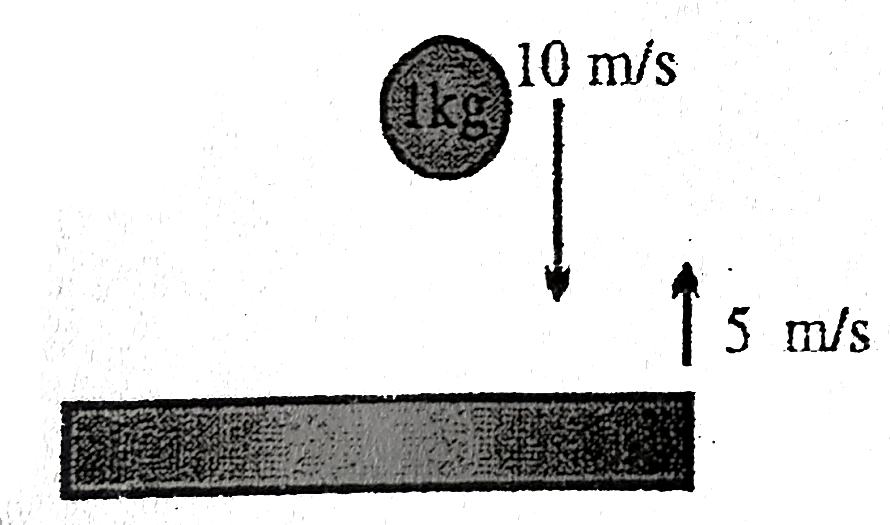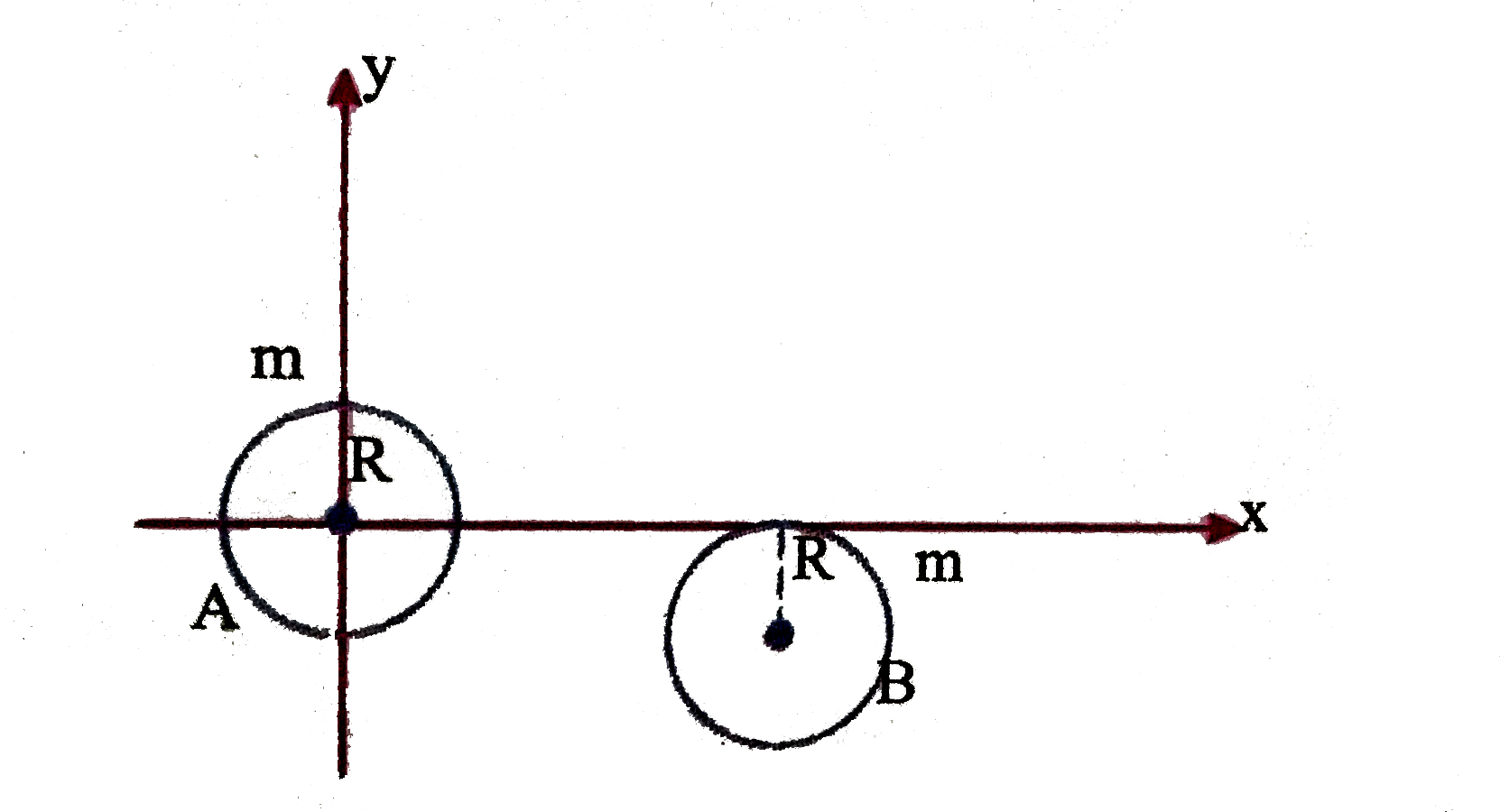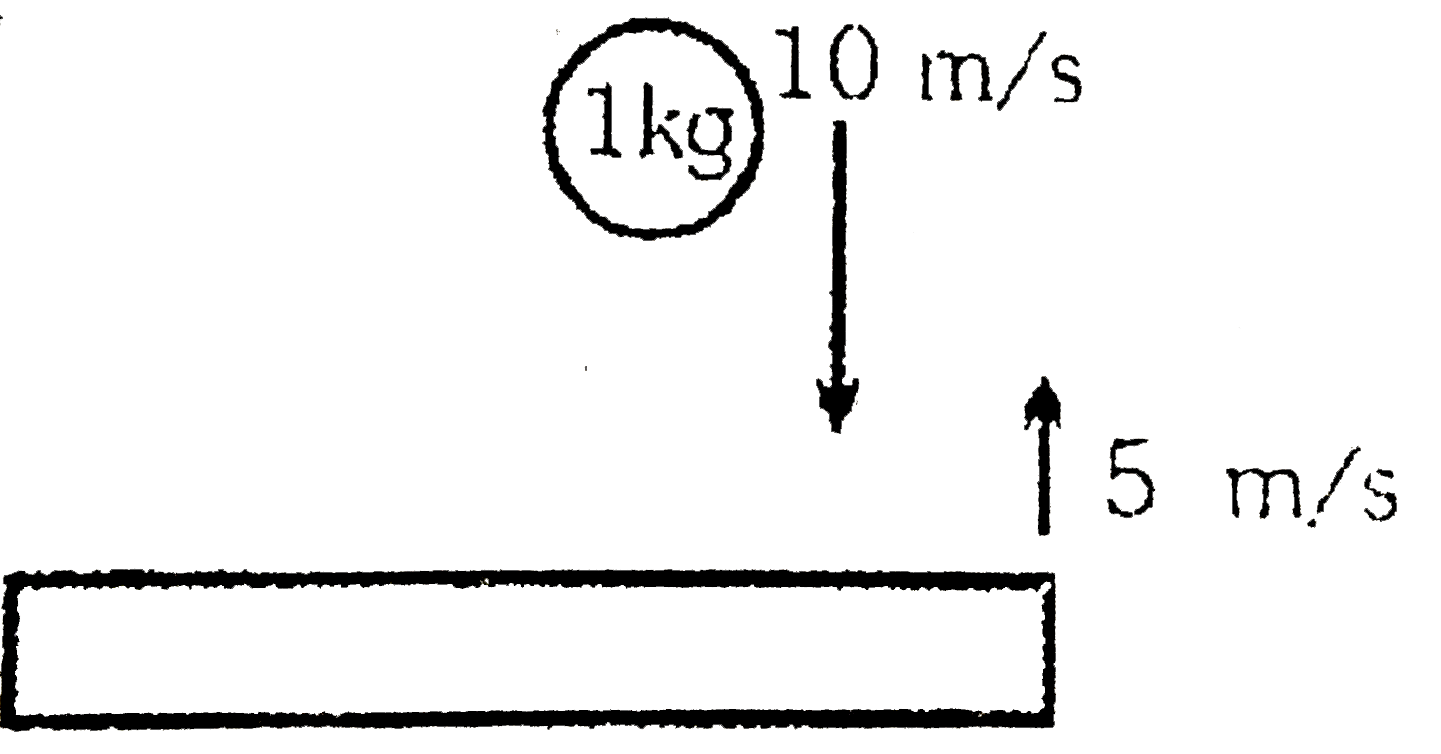A ball of mass 1 kg strikes a heavy platform, eleastically, moving upwards with a velocity of 5m/s. The speed of the ball just before the collision is 10m/s downwards. Then the impulse inparted by the platform on the ball is
 Solution in Gujrati
Solution in Gujrati
15N−s
10N−s
20N−s
30N−s
The correct Answer is:D
e=−(v2−v1u2−u1)⇒1=−5−v15−(−10)=v1−515
⇒v1=20m/s
∴ Impulse on ball =m(→v−→u)=1×[20−(10)]=30N−s
Topper's Solved these Questions
- CENTRE OF MASSBOOK - ALLEN CHAPTER - CENTRE OF MASSEXERCISE - EXERCISE-II
43 Videos
- CENTRE OF MASSBOOK - ALLEN CHAPTER - CENTRE OF MASSEXERCISE - EXERCISE-III
41 Videos
- CENTRE OF MASSBOOK - ALLEN CHAPTER - CENTRE OF MASSEXERCISE - EXERCISE-V B
19 Videos
- BASIC MATHEMATICS USED IN PHYSICS &VECTORS BOOK - ALLEN CHAPTER - BASIC MATHEMATICS USED IN PHYSICS &VECTORS EXERCISE - EXERCISE-IV ASSERTION & REASON
11 Videos
- ELASTICITY, SURFACE TENSION AND FLUID MECHANICSBOOK - ALLEN CHAPTER - ELASTICITY, SURFACE TENSION AND FLUID MECHANICSEXERCISE - Exercise 5 B (Integer Type Questions)
3 Videos
Similar Questions
Two particle A and B start moving due to their mutual interaction only. If at any tiem 't', →aA and →aB are their respective accelerations, →vA and →vB are their respective velocities, and upto that time WA and WB are the work done on A and B respectively by the mutual force, mA and mB are their masses respectively, then which of the following is alwys correct.
View SolutionA particle of mass m, kinetic energy K and momentum p collision head on elastically with another particle of mass 2m at rest. After collision. :
Column IColumn II(A)Momentum of first particle(p)3/4p(B)Momentum of second particle(q)−K/9(C)Kinetic energy of first particle(r)−p/3(D)Kinetic energy of second particle(s)8K9None
View SolutionTwo particles of masses m1 and m2 in projectile motion have velocities →v1 and →v2 , respectively , at time t=0. They collide at time t0. Their velocities become →v'1 and →v'2 at time 2t0 while still moving in air. The value of ∣∣∣(m1→v'1+m2→v'2)−(m1→v1+m2→v2)∣∣∣
View SolutionAssertion: If the initial and final positions coincide, the displacement is a null vector.
Reason: A physical quantity can not be called a vector, if its magnitude is zero.
View SolutionTwo soap bubbles A and B are kept in a closed chamber where the air is maintained at pressure 8N/m2.The radii of bubbles A and B are 2cm and 4cm, respectively. Surface tension of the soap-water used to make bubbles is 0.04N/m. Find tha ratio nB/nA, where nA and nB are the number of moles of air in bubbles A and B, respectively. [Neglect the effect of gravity.]
View SolutionA ball is moving with velocity 2m//s towards a heavy wall moving towards the ball with speed 1m//s as shown in figure. Assuming collision to be elastic, find the velocity of ball immediately after the collision.
View SolutionA platform is moving upwards with a constant acceleration of 2 m s^-2 . At time t = 0 , a boy standing on the platform throws a ball upwards with a relative speed of 8 m s^-1 . At this instant, platform was at the height of 4 m from the ground and was moving with a speed of 2 m s^-1 . Take g = 0 m s^-2 . Find (a) when and where the ball strikes the platform. (b) the maximum height attained by the ball from the ground. ( c) the maximum distance of the ball from the platform.
View SolutionAn elevator platform is going up at a speed of 20 m//s and during its upward motion a small ball of 50 g mass, falling in downward direction, strikes the platform at speed 5 m//s . Find the speed with which the ball rebounds.
View SolutionTwo smooth balls A and B, each of mass m and radius R, have their centres as shown in fig. Ball A, moving along positive x-axis, collides with ball B. Just before the collision, speed of ball 'A' is 4m/s and ball 'B' is stantionary. The collision

Velocity of the ball 'A' just after the collision is
View SolutionA ball moving vertically downward with a speed of 10m/s collides with a platform. The platform moves with a velocity of 5m/s in downward direction. If e=0.8, find the speed (in m/s ) of the ball just after collision.
View SolutionA ball of mass 1kg strink a heavy platform, elastically, moving upwards with a velocity of 5m/s. The speed of the ball just begore the collision is 10m/s downwards. Then the impulse imparted by the platform on the ball is :-

View SolutionA platform of infinite mass is moving upward with velocity 5m/s. At time t = 0, a ball which is at height 100 m above the platform starts falling freely. The velocity of ball just after the collision will be (Assume elastic collision) (g=10m/s2):
View SolutionA ball of mass 100g moving at a speed of 12 m s−1 strikes another ball of mass 200 g at rest. After the collision both the balls move with a common velocity. Find the common velocity.
View SolutionA 1 kg ball has a velocity of 12 m/s downward just before it strikes the ground and bounces up with a velocity of 12 m/s upward. What is the change in momentum of the ball?
View SolutionA ball of 2 kg mass, moving at a speed of 5m / s, collides with another ball of mass 3 kg moving in the same direction at a speed of 4m / s. If the inverse coefficient of collision is 2/3
View SolutionA ball moving with a velocity of 6 m/s strikes an identical stationary ball. After collision each ball moves at angle of 30^@ with the original line of motion. Assuming that the collision is elastic, what are the speeds of the balls after the collision?
View Solution
